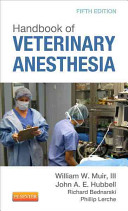Handbook of Veterinary Anesthesia, 5th Edition

Páté vydání veterinární anestezie je praktický, přehledný a úplný zdroj informací pro vykonání bezpečné a účinné anestezie malých, velkých a exotických zvířat. Uvedeny jsou všechny nejdůležitější aspekty veterinární anestezie, vyhodnocení okolností anestezie z pohledu pacientů, používaných anestetik a anestetických postupů. V publikaci jsou uvedeny ověřené dávky anestetik a analgetik.
Autor: William W. Muir, John A.E. Hubbell, Richard Bednarski, Philip Lerche
| Nakladatel | Elsevier Saunders |
|---|---|
| ISBN | 9780323080699 |
| Vydání | 2012 |
| Vazba | brožovaná |
| Počet stran | 600 |
Handbook of Veterinary Anesthesia, 4th Edition is a convenient, complete, and practical resource for administering safe and effective anesthesia to small and large animals, including exotic pets. Long valued by students and practitioners alike, this handbook features all the practical and applied aspects of veterinary anesthesia, including patient evaluation, preanesthetic medications, local anesthesia and anesthetic techniques, and more. The book describes drugs used perioperatively and their clinical applications in detail and pays special attention to complementary and integrative approaches to pain management.
Key Features
User-friendly format provides instant access to vital information on anesthetic procedures and techniques for dogs, cats, horses, ruminants, camelids, pigs, birds, and other exotic pets.
Thoroughly UPDATED topics include patient evaluation, patient preparation methods, safe and effective operation of anesthetic equipment, and chemical restraint procedures.
Respected authors are recognized as experts in the field of veterinary anesthesia.
Over 100 tables, boxes, and graphs summarize anesthetic protocols and clinical applications, including dosages, advantages, and disadvantages of each drug.
Also available on Pageburst - a fully searchable digital text platform that makes it easy to quickly find key topics and drug information. Sold separately.
| 1. Introduction to Anesthesia | 1 |
| 2. Animal Evaluation and Preparation | 12 |
| 3. Preanesthetic and Perioperative Medications | 22 |
| 4. Local Anesthetic Drugs and Techniques | 58 |
| 5. Local Anesthesia in Ruminants and Pigs | 76 |
| 6. Local Anesthesia in Horses | 101 |
| 7. Local Anesthesia in Dogs and Cats | 116 |
| 8. Injectable Anesthetic Drugs | 139 |
| 9. Inhalant Anesthesia and Inhalant Anesthetics | 163 |
| 10. Neuromuscular Blocking Drugs | 188 |
| 11. Equipment for Tracheal Intubation and Securing the Airway | 202 |
| 12. Anesthetic Machines and Breathing Systems | 210 |
| 13. Ventilation and Mechanical Assist Devices | 236 |
| 14. Monitoring During Anesthesia | 255 |
| 15. Acid-Base Balance and Blood Gases | 285 |
| 16. Perioperative Fluid Administration | 306 |
| 17. Temperature Regulation During Anesthesia: Anesthestic-Associated Hypothermia and Hyperthermia | 330 |
| 18. Pain and Pain Therapy | 348 |
| 19. Integrative Medicine: Acupuncture Analgesia | 366 |
| 20. Anesthetic Procedures and Techniques in Dogs | 379 |
| 21. Anesthetic Procedures and Techniques in Cats | 394 |
| 22. Anesthetic Procedures and Techniques in Horses | 405 |
| 23. Anesthetic Procedures and Techniques in Ruminants | 419 |
| 24. Anesthetic Procedures and Techniques in Pigs | 430 |
| 25. Anesthetic Procedures and Techniques inCamelides | 438 |
| 26. Anesthesia Procedures in Exotic Animals | 450 |
| 27. Anesthesia for Caesarean Section | 490 |
| 28. Respiratory Emergencies | 502 |
| 29. Cardiaovascular Emergencies | 519 |
| Appendix I: Physical Principles of Anesthesia | 542 |
| Appendix II: Drug Schedules | 548 |
| Index | 557 |